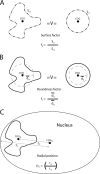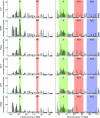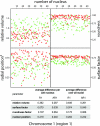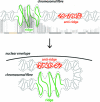The three-dimensional structure of human interphase chromosomes is related to the transcriptome map
- PMID: 17420274
- PMCID: PMC1900058
- DOI: 10.1128/MCB.00208-07
The three-dimensional structure of human interphase chromosomes is related to the transcriptome map
Abstract
The three-dimensional (3D) organization of the chromosomal fiber in the human interphase nucleus is an important but poorly understood aspect of gene regulation. Here we quantitatively analyze and compare the 3D structures of two types of genomic domains as defined by the human transcriptome map. While ridges are gene dense and show high expression levels, antiridges, on the other hand, are gene poor and carry genes that are expressed at low levels. We show that ridges are in general less condensed, more irregularly shaped, and located more closely to the nuclear center than antiridges. Six human cell lines that display different gene expression patterns and karyotypes share these structural parameters of chromatin. This shows that the chromatin structures of these two types of genomic domains are largely independent of tissue-specific variations in gene expression and differentiation state. Moreover, we show that there is remarkably little intermingling of chromatin from different parts of the same chromosome in a chromosome territory, neither from adjacent nor from distant parts. This suggests that the chromosomal fiber has a compact structure that sterically suppresses intermingling. Together, our results reveal novel general aspects of 3D chromosome architecture that are related to genome structure and function.
Figures








Similar articles
-
Domain-wide regulation of gene expression in the human genome.Genome Res. 2007 Sep;17(9):1286-95. doi: 10.1101/gr.6276007. Epub 2007 Aug 10. Genome Res. 2007. PMID: 17693573 Free PMC article.
-
Chromosome territories, interchromatin domain compartment, and nuclear matrix: an integrated view of the functional nuclear architecture.Crit Rev Eukaryot Gene Expr. 2000;10(2):179-212. Crit Rev Eukaryot Gene Expr. 2000. PMID: 11186332 Review.
-
Fluorescence intensity profiles of in situ hybridization signals depict genome architecture within human interphase nuclei.Tsitol Genet. 2008 Sep-Oct;42(5):3-8. Tsitol Genet. 2008. PMID: 19140435
-
Genome organization in the human sperm nucleus studied by FISH and confocal microscopy.Mol Reprod Dev. 2000 Mar;55(3):307-15. doi: 10.1002/(SICI)1098-2795(200003)55:3<307::AID-MRD9>3.0.CO;2-P. Mol Reprod Dev. 2000. PMID: 10657050
-
Dynamics and interplay of nuclear architecture, genome organization, and gene expression.Genes Dev. 2007 Dec 1;21(23):3027-43. doi: 10.1101/gad.1604607. Genes Dev. 2007. PMID: 18056419 Review.
Cited by
-
Fiber-Like Organization as a Basic Principle for Euchromatin Higher-Order Structure.Front Cell Dev Biol. 2022 Jan 31;9:784440. doi: 10.3389/fcell.2021.784440. eCollection 2021. Front Cell Dev Biol. 2022. PMID: 35174159 Free PMC article.
-
Chromosome territories and the global regulation of the genome.Genes Chromosomes Cancer. 2019 Jul;58(7):407-426. doi: 10.1002/gcc.22732. Epub 2019 Mar 18. Genes Chromosomes Cancer. 2019. PMID: 30664301 Free PMC article. Review.
-
Depletion of the chromatin looping proteins CTCF and cohesin causes chromatin compaction: insight into chromatin folding by polymer modelling.PLoS Comput Biol. 2014 Oct 9;10(10):e1003877. doi: 10.1371/journal.pcbi.1003877. eCollection 2014 Oct. PLoS Comput Biol. 2014. PMID: 25299688 Free PMC article.
-
Epigenetic regulatory layers in the 3D nucleus.Mol Cell. 2024 Feb 1;84(3):415-428. doi: 10.1016/j.molcel.2023.12.032. Epub 2024 Jan 18. Mol Cell. 2024. PMID: 38242127 Free PMC article. Review.
-
Energetics, epigenetics, mitochondrial genetics.Mitochondrion. 2010 Jan;10(1):12-31. doi: 10.1016/j.mito.2009.09.006. Epub 2009 Sep 29. Mitochondrion. 2010. PMID: 19796712 Free PMC article. Review.
References
-
- Archidiacono, N., R. Antonacci, R. Marzella, P. Finelli, A. Lonoce, and M. Rocchi. 1995. Comparative mapping of human alphoid sequences in great apes using fluorescence in situ hybridization. Genomics 25:477-484. - PubMed
-
- Boyle, S., S. Gilchrist, J. M. Bridger, N. L. Mahy, J. A. Ellis, and W. A. Bickmore. 2001. The spatial organization of human chromosomes within the nuclei of normal and emerin-mutant cells. Hum. Mol. Genet. 10:211-219. - PubMed
-
- Bridger, J. M., S. Boyle, I. R. Kill, and W. A. Bickmore. 2000. Re-modelling of nuclear architecture in quiescent and senescent human fibroblasts. Curr. Biol. 10:149-152. - PubMed
Publication types
MeSH terms
Substances
LinkOut - more resources
Full Text Sources
Other Literature Sources
Molecular Biology Databases
